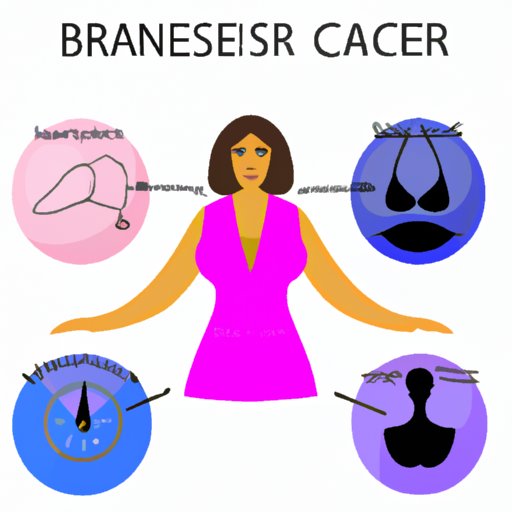
I. Introduction
Breast cancer is a disease that affects millions of women worldwide, and it’s important to understand the different methods of checking for it. In this article, we will provide a comprehensive guide to checking for breast cancer, including symptoms, self-examination techniques, screening methods, risk factors, and preventative measures. This article is intended for individuals who want to learn more about breast cancer and how to detect it early.
II. Symptom Check
Breast cancer is a type of cancer that affects breast tissue. The most common symptoms include the following:
– A lump in the breast or armpit
– Thickening or swelling of part of the breast
– Dimpling or puckering of the skin on the breast
– A change in nipple position or shape
– Discharge from the nipple
– Constant pain in one part of the breast
If you notice any of these changes to your breasts, it is important to see a doctor immediately. Early detection is key to successful treatment.
III. Self-Examination
One way to catch breast cancer early is to perform regular self-examinations. It is recommended that women perform a self-examination once a month. Here is a step-by-step guide to performing a self-examination:
- Begin by lying down on your back with a pillow under your right shoulder.
- Use your left hand to examine your right breast. Use a firm, smooth touch with the pads of your fingers.
- Start at the outer edge of your breast and move your fingers in a circular motion, feeling for any lumps or thickened areas.
- Move your fingers in small, overlapping circles around your entire breast.
- Repeat these steps on your left breast.
When examining your breasts, look for any lumps or changes in texture. You should also check your nipples for any abnormalities. If you notice any changes or abnormalities, see a doctor immediately.
IV. Screening Methods
There are several different methods of screening for breast cancer, including mammograms, ultrasounds, and MRIs. The most common screening method is a mammogram, which uses X-rays to take images of the breast tissue. The recommendation for screening varies depending on age group and family history, so it’s important to speak with your healthcare provider about which method and frequency of screening is right for you.
A mammogram is typically performed by compressing the breast tissue between two plates. It may be uncomfortable, but it only takes a few minutes to complete. An ultrasound may be used in tandem with a mammogram to further investigate any abnormalities detected during a mammogram or to screen women with dense breast tissue. MRI is a powerful test that uses a magnetic field and radio waves to generate detailed images of the breast. It is typically reserved for high-risk patients and those with difficult-to-interpret mammograms.
It’s important to note that each screening method has benefits and limitations, and doctors often use a combination of screening methods to ensure the most accurate diagnosis.
V. Risk Factors
There are several risk factors that may increase the likelihood of a woman developing breast cancer. These risk factors include the following:
– Gender (it’s more common in women than men)
– Age (risk increases as a woman gets older)
– Family history (BRCA1 and BRCA2 mutation, or other first-degree relatives with the disease)
– Exposure to radiation
– Early menstruation onset
– Late menopause onset
– Obesity
– Alcohol consumption
– Hormone therapy use
Having one or more of these risk factors doesn’t necessarily mean that you will develop breast cancer. Conversely, many women with breast cancer have no known risk factors. Discuss your risk factors with your healthcare provider to determine your individual risk and screening recommendations.
VI. Lifestyle Changes
While some risk factors, such as genetics or age, cannot be controlled, there are lifestyle changes you can make to reduce your risk of breast cancer:
- Stay physically active. Regular exercise can reduce the risk of breast cancer and improve overall health.
- Eat a healthy diet. A diet with plenty of fruits, vegetables, and whole grains can decrease the risk of many types of cancer, including breast cancer.
- Avoid smoking. Smoking has been linked to breast cancer and numerous other health problems.
- Limit alcohol consumption. Drinking alcohol in moderation (one drink or less per day) is generally safe, but heavy drinking increases the risk of breast cancer.
By making these simple lifestyle changes, you can reduce your risk of breast cancer and improve your overall health.
VII. Family History
If you have a family history of breast cancer, you may be at an increased risk of developing the disease. It is important to discuss your family history with a healthcare provider to assess your risk. In some cases, genetic counseling and testing may be recommended to determine the risk of genetic mutations, such as BRCA1 and BRCA2, that increase the risk of breast and ovarian cancer.
VIII. Precautionary Measures
For individuals who are at high risk of developing breast cancer, preventative measures may be recommended. These measures may include prophylactic surgery to remove the breasts or ovaries, medication, or a combination of both.
It is important to discuss these options with a healthcare provider to determine the best course of action for your individual circumstances. It’s also important to weigh the benefits and risks of each option carefully.
IX. Conclusion
Breast cancer is a serious disease, but with early detection and proper treatment, the survival rate is high. By being proactive about your health, you can catch breast cancer early, reduce your risk, and ensure the best possible outcome if you are diagnosed. Stay informed, know your risk factors, and speak with your healthcare provider about screening, self-examination, and preventative measures.
We hope that this guide has been informative and helpful in your journey to maintaining good breast health.





